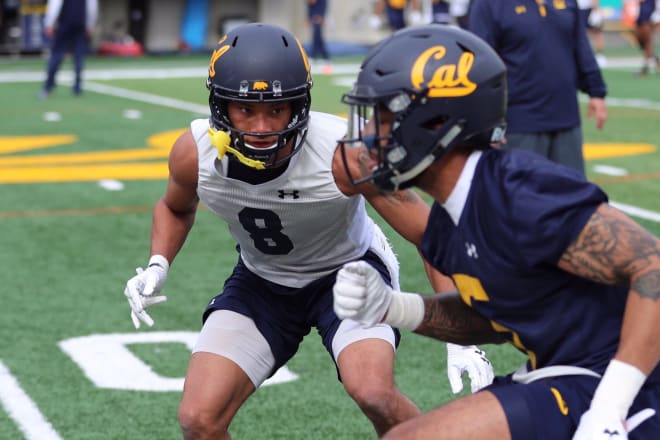Friday Thoughts: Where the Bears Go Without Robertson

So your five star generational athlete has transferred, and you need some help coping.
*pulls up chair, Captain America PSA style*
Hi. I’m Nam Le, author of notable, usually awful Cal takes like “#drop50”, “Run the Dang Ball Jake”, “this is the year with beat USC no really”, “USC is our real rival: galaxy brain” and “Surprise Onside.” Today, I’m here to help you face life without Demetris Robertson.
The first thing you need to know is that departure of a star player is a normal, natural occurrence – whether it be by graduation, early draft declaration, or transfer, it’s important to keep in mind that every player’s time in college is fleeting and ultimately finite. When it comes to transferring, each decision to do should be understood as a unique situation faced by a unique individual; not always as a referendum upon the program they left.
Besides, had it not happened this week, Demetris would still one day move on from the Yale Blue and Gold anyway, perhaps even as soon as the end of this season. We wish him well, as we would whether the departed were a walk-on or a five star.
This does, of course, leave the roster with a void to the exact dimensions of…basically anyone who can run a 4.4 40, and the Bears will still be tasked with filling it with something more than good will. Generational-type athletes don’t just grow on trees in Strawberry Canyon – this isn’t exactly Alabama, after all – so there isn’t an obvious “one solution” to the issue. Instead, they’ll do their best to compensate without him by using contributions from several different areas.
In a sense, Cal has already had to prepare for the post Demetris Robertson era already – as much as his injury was a disaster for the last season’s offense, it’s already forced Beau Baldwin and Justin Wilcox play without his vertical threat, similar to how losing Devante Downs gave the team a head start grooming Jordan Kunaszyk and Gerran Brown.
In offseason interiews and throughout the spring, Wilcox has been fairly open about the team’s lack of a deep passing game, which could conceivably still be schemed along in year two under Baldwin. When teams lack transcendent athletes at the wide receiver position, they often tinker with things like bunch formations, stacks, motion, or splits in order to create separation –and that’s not including less noticeable schematic tweaks that would be lost on the eyes of more casual fans like myself. These are also things the Cal offense did not exactly employ to the fullest extent last season that might be more necessary now.
They’ll also continue to lean on running back and future legend Patrick Laird as an all-purpose threat, plus whichever backup will spell him, whether it’s Derrick Clark, Johnny Adams, or Chris Brown. Add in what should be an increased presence of a quarterback run threat from both Ross Bowers and McIlwain, and you’ve made up some of the ground already. If defenses have to pay more attention to this area of the offense, there should be way more room for everyone else to operate. (Plus, the Bears were only 46th in Rushing Success Rate last year and 73rd in isoPPP, metrics that suggested that they were more successful at chipping away on the ground than generating explosiveness. With more options, a second year of Laird, and all the returning linemen, it feels safe to project the receivers will see more single-high coverages to work against next year.)
With this being year two of the offense under Baldwin, there should also be internal improvement in general from that alone, but the scholarship receivers who weren’t quite ready to fill in for Robertson last year will be pressed for the most gains. Jeremiah Hawkins, Brandon Singleton, and Jordan Duncan will once again all get another crack at the targets that would have been D-Rob’s; the latter two are now firmly veterans on this team. Their time is now, if ever.
Finally, we have new personnel – guys who weren’t on the field last season for one reason or another, but figure to be now, if all things break well. We mention Ray Hudson a lot in season previews, but with good reason. Finally back at his native tight end for one last go-around, the sixth-year should provide a bigger pass-catching threat than the Bears had in 2017. His main value will be opening up the middle of the field in a different way than Robertson might have -- not with speed, but by forcing safeties and linebackers to come out of the box to follow him in routes, which in turn unlocks space for everyone else. The actually new faces will be Taariq Johnson, who red-shirted but has had a tremendous spring, and Mater Dei product/true freshman Nikko Remigio, who’ll be given every chance to play right away if he’s ready.
When you add all of those things up – possible schematic tweaks, new run game threats, internal improvements, and the new players, you might approach 70-80% of what a fully healthy D-Rob would have brought this fall. After all, the realistic scenario is only some of these things come to fruition. Laird might continue to be amazing, but maybe only Hudson steps up from the pass catchers group.
In a sense, what we’re looking for is a combination of these things that ends up being worth another win in the margins, or at least, avoids another sure loss in the net calculus. It’s still not ideal to have to replace D-Rob, but it rarely ever is here in Berkeley. We’ll just do the best we can, because it’s always hard here.
Especially because it’s always hard here.